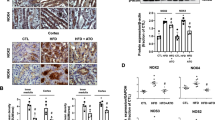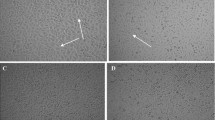Abstract
Statins is an inhibitor in the cholesterol biosynthesis pathway. Simvastatin (SIM) has been found to have other clinical benefits besides those resulted from its actions of reducing plasma level of low density lipoprotein (LDL) cholesterol. Both mevastatin (MEV) and parvastatin (PAR) can increase release of nitric oxide (NO) which is a potent inhibitor of platelet aggregation and endothelial cell conglutination. In this study, we found different concentrations of SIM had different effects on 3-hydroxy-3-methylglutaryl-CoA reductase (HMGR) mRNA expression and NO and total cholesterol (TC) in normal cultural pig kidney cells. NO and TC were measured by using colorimetry in 550 nm and 546 nm, respectively. HMGR mRNA expression was tested by RT-PCR. Results showed that HMGR mRNA expression had a significant difference (P < 0.05) between different concentration of SIM treatment (0, 5, 10, or 25 μmol/l). HMGR mRNA expression and TC content decreased gradually with the elevation of SIM concentration. The content of NO increased with the elevation of SIM concentration, but the difference was not notable. SIM affects the expression of HMGR-CoA, TC and NO in normal cells, but the specific mechanism need to be further research.

Similar content being viewed by others
References
Simens K, Ikonen E (2000) How cells handle cholesterol. Science 290:1721–1726. doi:10.1126/science.290.5497.1721
Jiang JH, Kai GY, Cao XY, Chen FM, He DN, Liu Q (2006) Molecular cloning of a HMG-CoA reductase gene from Eucommia ulmoides oliver. Biosci Rep 26:171–181. doi:10.1007/s10540-006-9010-3
Istvan ES, Deisenhofer J (2000) The structure of the catalytic portion of human HMG-CoA reductase. Arch Biochem Biophys 1529:9–18
NRC (1980) Toward healthful diets. Food and Nutrition Board. National Academy of Science, Washington, DC
NRC (1989) Diet and health: implications for reducing chronic disease risk. Committee on Diet and Health, National Research Council. National Academy Press, Washington, DC
West of Scotland Coronary Prevention Study Group (1998) Influence of pravastatin and plasma lipids on clinical events in the West of Scotland Coronary Prevention Study (WOSCOPS). Circulation 97:1440–1445
Vaughan CJ, Murhy MB, Buckley BM (1996) Statins do more than just lower cholesterol. Lancet 348:1079–1082. doi:10.1016/S0140-6736(96)05190-2
Cattaneo D, Remuzzi G (2005) Lipid oxidative stress and the anti-inflammatory properties of statins and ACE inhibitors. J Ren Nutr 15:71–76. doi:10.1053/j.jrn.2004.09.029
Athyros VG, Mikhailidis DP, Papageorgiou AA, Symeonidis AN, Bouloukos VI, Elisaf M (2004) The effect of statins versus untreated dyslipidaemiaon renal function in patients with coronary heart disease. A subgroup analysis of the Greek atorvastatin and coronary heart disease evaluation (GREACE) study. J Clin Pathol 57:728–734. doi:10.1136/jcp.2003.012989
Van TA, Van GT, Scheek LM, Groener JE (1991) Lipoprotein structure and metabolism during progression and regression of atherosclerosis in pigs fed with fish oil-derived fatty acids. Adv Exp Med Biol 285:417–421
Chen GP, Yao L, Lu X, Li L, Hu SJ (2008) Tissue-specific effects of atorvastatin on 3-hydroxy-3-methylglutaryl-coenzyme A reductase expression and activity in spontaneously hypertensive rats. Acta Pharmacol Sin 29(10):1181–1186. doi:10.1111/j.1745-7254.2008.00855.x
Brown MS, Goldstein JL (1997) The SREBP pathway: regulation of cholesterol metabolism by proteolysis of a membrane-bound transcription factor. Cell 89:331–340. doi:10.1016/S0092-8674(00)80213-5
Goldstein JL, Brown MS (1990) Regulation of the mevalonate pathway. Nature 343:425–430. doi:10.1038/343425a0
Brown MS, Goldstein JL (1986) A receptor-mediated pathway for cholesterol homeostasis. Science 232:34–47. doi:10.1126/science.3513311
Goldstein JL, Hobbs HH, Brown MS (1995) Familial hypercholesterolemia. In: Scriver CR, Beaudet AL, Sly WS, Valle D (eds) The metabolic and molecular bases of inherited disease. McGraw-Hill, Inc., New York, pp 1981–2030
Bezerra DG, Mandarim-de-Lacerda CA (2005) Beneficial effect of simvastatin and pravastatin treatment on adverse cardiac remodeling and glomeruli loss in spontaneously hypertensive rats. Clin Sci 108:349–355. doi:10.1042/CS20040292
Yang L, Gao YJ, Lee RM (2005) The effects of quinapril and atorvastatin on artery structure and function in adult spontaneously hypertensive rats. Eur J Pharmacol 518:145–151. doi:10.1016/j.ejphar.2005.05.009
Miettinen TA, Gylling H (2003) Synthesis and absorption markers of cholesterol in serum and lipoproteins during a large dose of statin treatment. Eur J Clin Invest 33:976–982. doi:10.1046/j.1365-2362.2003.01229.x
Ribeiro MO, Antunes E, Nucci G, Lovisolo SM, Zatz R (1992) Chronic inhibition of nitric oxide synthesis. A new model of arterial hypertension. Hypertension 20:98–303
Haynes WG, Noon JP, Walker BR, Webb DJ (1993) Inhibition of nitric oxide synthesis increase blood pressure in healthy humans. J Hypertens 11:1375–1380. doi:10.1097/00004872-199312000-00009
Celermajer DS, Sorensen KE, Gooch VM, Spiegelhalter DJ, Miller OI, Sullivan ID, Lloyd JK, Deanfield JE (1992) Non-invasive detection of endothelial dysfunction in children and adults at risk of atherosclerosis. Lancet 340:1111–1115. doi:10.1016/0140-6736(92)93147-F
Celemajer DS, Sorensen KE, Bull C, Robinson J, Deanfield JE (1994) Endothelium dependent dilation in the systemic arteries of asymptomatic subjects relates to coronary risk factors and their interaction. J Am Coll Cardiol 24:1468–1474
Yokoyama M (2004) Oxidant stress and atherosclerosis. Curr Opin Phar 4:110–115. doi:10.1016/j.coph.2003.12.004
Moncada S, Palmer RMJ, Higgs EA (1991) Nitric oxide: physiology and pharmacology. Pharmacol Rev 43:109–142
Raymond MA, Patrick V (1994) Nitric oxide in essential and renal hypertension. J Am Soc Nephrol 5:1057–1065
Acknowledgements
The authors greatly appreciate Beijing Breeding Swine Centre for providing materials and Institute of Animal Science, Chinese Academy of Agricultural Sciences for their cell technical assistance. This study was supported by National Scientific and Technical Supporting Programs of China (No. 2006BAD13B08).
Author information
Authors and Affiliations
Corresponding authors
Rights and permissions
About this article
Cite this article
Liu, G., Lin, H., Fu, J. et al. Effect of simvastatin on culturing of kidney cells from pigs in vitro. Mol Biol Rep 37, 1391–1395 (2010). https://doi.org/10.1007/s11033-009-9522-6
Received:
Accepted:
Published:
Issue Date:
DOI: https://doi.org/10.1007/s11033-009-9522-6




